

Tupbak (San Blas Islands)
08° 59.50 N 077° 45.00 W
| Page 1 of 1 |
13 to 15 September 2007 |
We would like to take this opportunity to introduce the Kuna to you.
We are writing this in Isla Linton, some 30 miles from the Kuna territory, and its a rainy afternoon three months after our first arrival in the Kuna Yala. Our sources for this brief history are two books and our own experiences. See the bibliography at the end for credits.
14000 years ago the ancestors of the Kuna crossed the land-bridge over the Bering Straits. The original tribes further colonized the Americas as we now know them. Things seem to have been comparatively peaceful for thousands of years until the discovery of these lands by European powers and their thirst for gold.
The Kuna history is intermeshed with that of the other original tribes of the region but the Kuna were arguably those who resisted colonisation and integration most successfully as evidenced by their ancient ways, their dress and their sociological concepts. Un-subjugated they have thrived since those early days.
Kuna wisdom makes it illegal to pan for gold in the rivers. The logic is that every time gold is discovered, an invasion follows.
In 1925 the Kuna under their leader Nele Kantule rebelled against the Government and executed all mixed blood Kuna amongst others.
Reprisals were prevented by the presence of US forces, the result was autonomy and the establishment of; a Kuna Reserve "Comarca de Kuna Yala", Legal and autonomous administration under "La Carta Organica", The Congreso General, and three elected Sahilas which meets biannually and has Panamanian government observers attending.
The Kuna have also resisted to a great degree the invasion of religious zealots and missionaries, and although some churches have been built, on the islands we have visited, they were the only locked buildings in evidence and rarely used.
The religion of the Kuna is Ibeorgun. Paba (God) and Nana (the earth mother) sent all the peoples to the world, They then sent the Nele (prophets) to organise life on earth. The greatest prophet was Ibeorgun, it was he that taught the Kuna all their knowledge of survival, customs and dress. It was also he that taught them about community life, loving and sharing.
The spiritual side includes layers of spiritual realms, above and below earth, which appears to be somewhere in the middle.
Statuettes, chants and herbalism play important roles in the sociospiritual life of the Kuna, and their medicine is part of this sphere.
All other religions are treated with disdain as "They arrived late, and mostly with arrogance and disrespect". Mixed marriages are still forbidden and any transgressors, even covert, are deported.
Geographically the Kuna Yala (Land of the Kuna) extends from the Colombian border in the east, to the tip of Punta San Blas, 230 Km westward. A strip of coastal land, hilly and fertile rain-forest, with 350 odd outlying islands of beauty only exceeded by their diversity.
The waters are fertile with healthy coral and plentiful fish. The submarine topography is also hilly with the many scattered islands varying in size . Lower peaks are seen as reefs and reef systems that outnumber the islands. The passages in between are deep and easily navigable. The water is warm year-round and the seasons are split into the dry, from December to June, with easterly winds in the 15 -30 knot range, and the wet, in the balance of the year with long periods of calm punctuated by squalls and rainstorms of biblical proportions that can be enjoyed from safe anchorages.
The Kuna themselves are small in stature and immensely strong. Only the Pygmies are a smaller race. They are friendly and have a wonderful sense of fun, and a sense of humour.
We were able to joke with them in Spanish which most understand, about their (lack of) prowess fishing, and other things. They seem to look for the lighter side of everything.
The photos of them sailing with me while I was windsurfing was pure delight, with them tacking up and down with a huge sense of enjoyment, crowds on the beach cheering every successful tack.
The men do not dress up, they will normally wear longer trousers unless involved in fishing or some wet activity. They almost always wear baseball caps, a modern replacement for more traditional sun protection.
Mens hair is usually short to medium, always black, straight and healthy.
On the other hand women take pains to dress well. The Mola was originally derived from body painting.
The pictures here explain the dress, The Mola, is a blouse in light fabric with puffy sleeves and a boat neck, to which the reverse applique multicoloured mola is attached, the design is inspired by every day life here, and the front and back panels usually relate to each other.
A wrap skirt, headscarf and wini beads complete the dress. Chinese sandals are now usually included.
The traditional concept of beauty is that fore arms and calves are small, even underdeveloped by European standards, and even accentuated by tightly wrapping the wini around these parts.
Large bellies are common and possibly desirable. Thighs are never shown and Uaga (foreigners) are possibly seen as uncouth wearing our swimsuits.
The women also have gold jewellery including a nose ring through the septum. The hair is cut upon onset of menses and is a sign of maturity and eligibility for marriage. (long hair in some middle aged cruisers is confusing to the less visited islanders) A black line drawn from the tip of the nose to the bridge, and red blush comprises the make-up.
From what we observed, the more eastern islands are less tainted by western values than those closer to the Panama Canal. Labour was recruited from here, and inevitably the tourists are coming to the islands more and more. We think that the Kuna ways are better, for the Kuna, and the evidence of this sociological pollution was hard to contemplate in islands such as Nargana.
In Isla Pinos, the traditions were stronger and the Sahila welcomed us but requested that we leave the island at or near sunset unless invited for a specific feast or ceremony.
Everything about their culture functions if it is not polluted. Simple but important things like "Baby-sitting" to them is a pleasure, undertaken by all in the course of daily life.
A Kuna couple would get into their Ulu and paddle out to see us, they might or might not have children on board, the children might or might not be theirs, it would not matter, all of the villagers tend the children of all, as if their own.
To do it for money is a completely alien concept and had them rolling with laughter as we explained it.
I quote from a book by Michel Lecumberry, who in turn quotes from a speech by Sahila Argar Olonaidiginia made at the Congreso General in Carti-Sugtupu in 1991.
"Today we know very little about what we have lost, and the little that we do know, we are also losing because they* have put a disease called money in our head.
Even the school** teaches only how to make money, to make more and more of it, and this is totally contrary to our culture and our values.
It is because of this that we say the invasion has not ended, It continues to kill our boys, our daughters, and our elders, by eliminating our culture.
Now it is we, ourselves and our children who are helping the invasion of the Uaga.
We are forgetting the value of our culture and we believe that we are more evolved when we behave more like the Uaga, we do not realise the regression into which we plunge""
* The invasion of the Uaga (foreigner) which has continued for 500 years.
** The Panamanian school curriculum.
Life here is extremely relaxed, but at the same time disciplined.
The Sahilas have great power and their bidding is always carried out, possibly not with the same sense of urgency that they intended, but carried out nonetheless.
The law here is written and approved by the Kuna themselves.
Ceremonies play a large part in the life of a the Kuna. Birth, maturity, marriage, and funerals are all celebrated in different ways, but are always accompanied by crowds of varying sizes, chants, and sometimes Chicha Fuerte, a potent local brew of fermented sugarcane and more. These ceremonies follow a strict protocol.
Music is a central part of life here, from birth to death, song and chant will have been invoked to cure a headache, or even for good luck in an upcoming exam. Most instruments are pan type flutes and rattles, accompanied by chants in various harmonies. Talent is not a prerequisite to perform, and what they lack in skill is certainly made up by enthusiasm. Kuna music is, let us say unique, and from our perspective not as enjoyable as Andean music for example.
Spirituality plays a huge role in the medicine here too. Basically there are good and bad spirits, just as mother earth must be in equilibrium for all to be well, so there must be a balance between the good and bad spirits.
The medicine men (Nele) really do seem to have some power, or at least an understanding of the forces at work during an illness. A certain amount of their success might be auto-suggestive as the patients have complete faith in their abilities. The Nele do sometimes call on western doctors from the clinics, but only at the suggestion of the spirits.
Our time in the San Blas was certainly a highlight in our cruising life. This is undoubtedly one of the best places we have ever been. It is not a place where we could live, or even stay for a year, there is a lack of stimulation, and "normal" supplies are hard to find. Their culture is interesting and in our opinion they have a wonderful lifestyle, but, we will always be the outsiders, and the experience will be through a lens of cultural difference. The San Blas is however, a "Must See"
Sources:
The Panama Cruising Guide by Eric Bauhaus ISBN 9962-02-829-9
San Blas - Molas and Kuna traditions by Michel Lecumberry ISBN 2-9522170-1-7
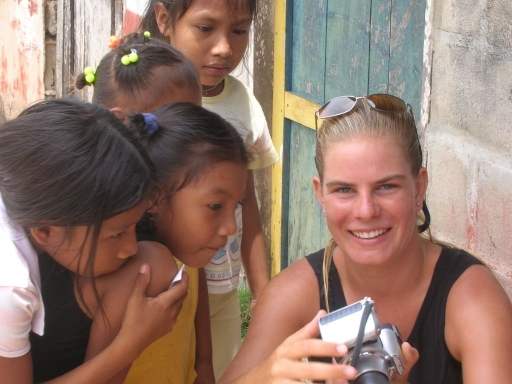
Our first contact with the Kuna was in Isla Pinos. They were friendly and welcoming, inquisitive and endearing. Here, they have chosen to keep the Kuna tradition, and modern technology was scarce. Here Liz shows them their photos, in the viewfinder of the camera.

These villages were spotless and well organized. Here dugout canoes, or Ulus wait to be used the next day, they are hauled out of the water every night to dry.
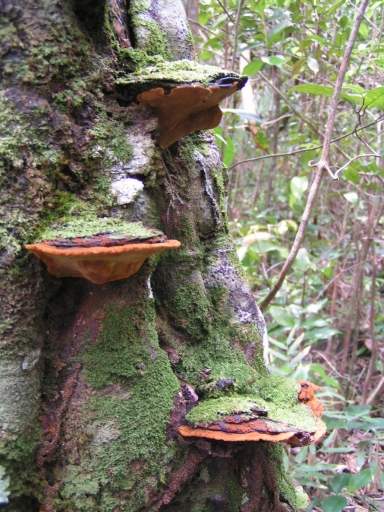
Fungus on trees, the rainfall and humidity were high here.
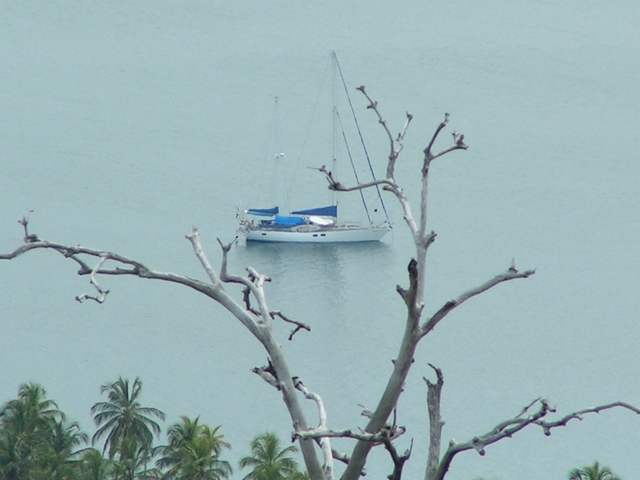
Liz went for a walk with some other boaters. A radio relay tower made a perfect vantage point for a photo of Gilana anchored below.
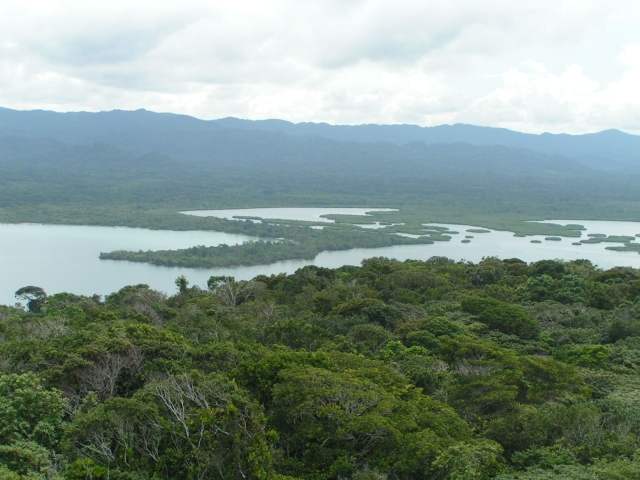
Looking South from the radio tower, in the foreground, Isla Pinos, then the channel, then mangrove swamps, then the mountains of Panama, beyond them 30 miles away, the Pacific Ocean.
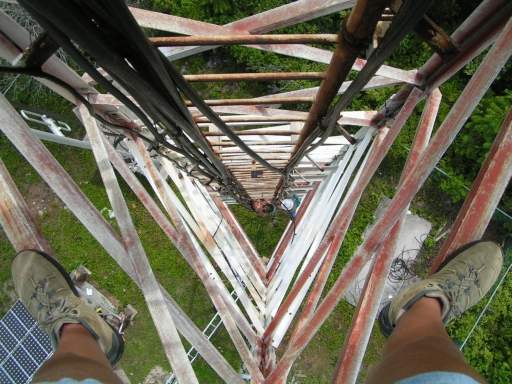
A view looking straight down the radio tower.
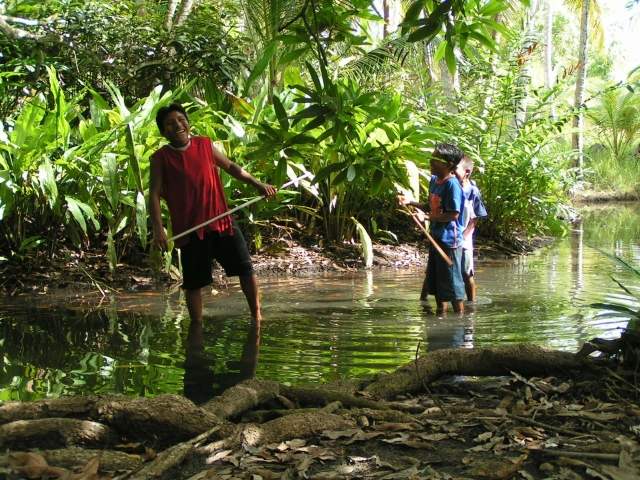
These kids seemed to be playing with sticks, until Liz asked them what they were doing. Those are blowpipes, and they were hunting birds with poison tipped darts. Liz asked for a demonstration and the younger one shot his dart through a target leaf. The poison comes from an orange frog, apparently the darts are rubbed on the back of the frog.
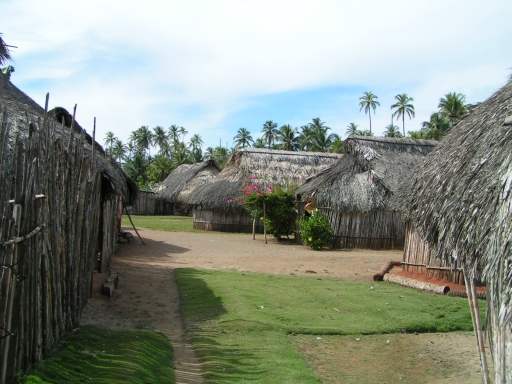
A sense of order and peace.

This young Kuna lad could not wait to show the "Faces" (white people) his pet bird in the reed cage he holds. His shy sister nervously looks on.